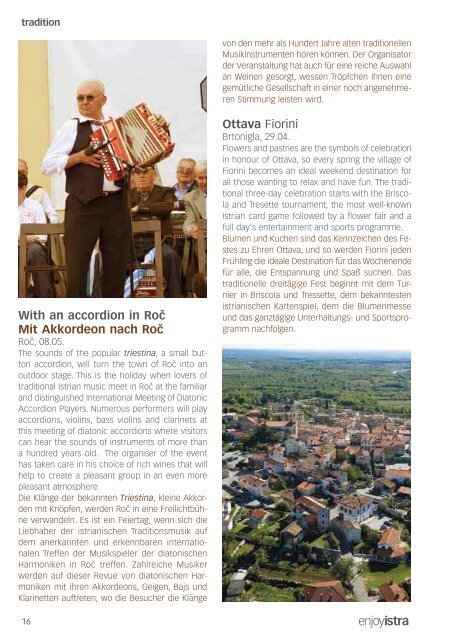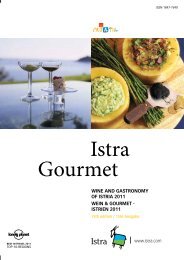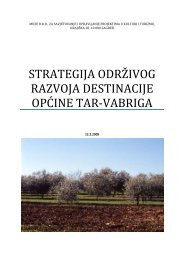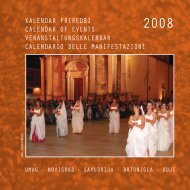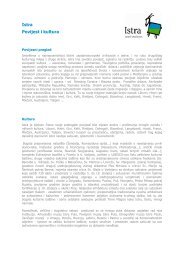enjoyistra
enjoyistra
enjoyistra
Erfolgreiche ePaper selbst erstellen
Machen Sie aus Ihren PDF Publikationen ein blätterbares Flipbook mit unserer einzigartigen Google optimierten e-Paper Software.
tradition<br />
tradition<br />
von den mehr als Hundert Jahre alten traditionellen<br />
Musikinstrumenten hören können. Der Organisator<br />
der Veranstaltung hat auch für eine reiche Auswahl<br />
an Weinen gesorgt, wessen Tröpfchen Ihnen eine<br />
gemütliche Gesellschaft in einer noch angenehmeren<br />
Stimmung leisten wird.<br />
With an accordion in Roč<br />
Mit Akkordeon nach Roč<br />
Roč, 08.05.<br />
The sounds of the popular triestina, a small button<br />
accordion, will turn the town of Roč into an<br />
outdoor stage. This is the holiday when lovers of<br />
traditional Istrian music meet in Roč at the familiar<br />
and distinguished International Meeting of Diatonic<br />
Accordion Players. Numerous performers will play<br />
accordions, violins, bass violins and clarinets at<br />
this meeting of diatonic accordions where visitors<br />
can hear the sounds of instruments of more than<br />
a hundred years old. The organiser of the event<br />
has taken care in his choice of rich wines that will<br />
help to create a pleasant group in an even more<br />
pleasant atmosphere.<br />
Die Klänge der bekannten Triestina, kleine Akkorden<br />
mit Knöpfen, werden Roč in eine Freilichtbühne<br />
verwandeln. Es ist ein Feiertag, wenn sich die<br />
Liebhaber der istrianischen Traditionsmusik auf<br />
dem anerkannten und erkennbaren internationalen<br />
Treffen der Musikspieler der diatonischen<br />
Harmoniken in Roč treffen. Zahlreiche Musiker<br />
werden auf dieser Revue von diatonischen Harmoniken<br />
mit ihren Akkordeons, Geigen, Bajs und<br />
Klarinetten auftreten, wo die Besucher die Klänge<br />
Ottava Fiorini<br />
Brtonigla, 29.04.<br />
Flowers and pastries are the symbols of celebration<br />
in honour of Ottava, so every spring the village of<br />
Fiorini becomes an ideal weekend destination for<br />
all those wanting to relax and have fun. The traditional<br />
three-day celebration starts with the Briscola<br />
and Tresette tournament, the most well-known<br />
Istrian card game followed by a flower fair and a<br />
full day’s entertainment and sports programme.<br />
Blumen und Kuchen sind das Kennzeichen des Festes<br />
zu Ehren Ottava, und so werden Fiorini jeden<br />
Frühling die ideale Destination für das Wochenende<br />
für alle, die Entspannung und Spaß suchen. Das<br />
traditionelle dreitägige Fest beginnt mit dem Turnier<br />
in Briscola und Tressette, dem bekanntesten<br />
istrianischen Kartenspiel, dem die Blumenmesse<br />
und das ganztägige Unterhaltungs- und Sportsprogramm<br />
nachfolgen.<br />
The traditional Istrian garden is<br />
a small garden located in the leeward direction<br />
of a traditional Istrian house, hidden from attacks<br />
of strong wind and strong sun. The garden had<br />
to be fenced off with a stone wall, which was<br />
built high on the northern part to protect it from<br />
attacks from the bura wind whilst the walls on<br />
the southern side were lower, but high enough<br />
to let the sun get through to it whilst leaving<br />
domestic animals out of it. Entrance is provided<br />
through an opening in the wall closed by a wooden<br />
gate. The land was cultivated, watered and<br />
weeded manually; people seeded and planted<br />
everything necessary for cooking and preparing<br />
food. Amongst the vegetables most often cultivated<br />
were salad, radicchio, beans, green peas,<br />
cabbage and string beans whilst amongst the<br />
culinary herbs there were sage, mint, wormwood,<br />
rosemary, basil, laurel and parsley as well<br />
as the inescapable spices fennel, cumin, horseradish<br />
and celery. Special charm is given to the<br />
garden by the fully blossoming fruit-trees - fig,<br />
quince, apple, and pear.<br />
Ein istrischer Traditionsgarten<br />
ist ein kleiner Garten gelegen im Windschatten eines<br />
traditionellen istrischen Hauses, versteckt vor starken<br />
Windschlägen und starker Sonne. Der Garten wurde<br />
unbedingt durch eine Steinwand eingezäunt, auf der<br />
nördlichen Seite zum Schutz vor den Windschlägen<br />
der bura hoch erhoben, während auf der südlichen<br />
Seite die Wände niedriger, aber dennoch hoch genug<br />
waren, damit der Garten gleichzeitig besonnt<br />
und dennoch vor heimischen Tieren geschützt wurde.<br />
Man gelangte durch eine Öffnung in der Wand,<br />
verschlossen durch eine hölzerne Tür, in ihn hinein.<br />
Die Erde wurde manuell bearbeitet, gegossen und<br />
gejätet. Es wurde alles gesät und gepflanzt was zum<br />
Kochen und Zubereiten von Speisen benötigt wurde.<br />
Vom Gemüse am häufigsten Salat, Blaukraut, Bohnen,<br />
Erbsen, Kohl und Fissolen, von Gewürzpflanzen<br />
Salbei, Minze, Edelraute, Rosmarin, Basilikum, Lorbeer<br />
und Petersilie, aber auch die unumgänglichen<br />
Gewürze Fenchel, Kümmel, Kren und Sellerie. Dem<br />
Garten verleihen die Obstbäume in ihrer vollen Blüte<br />
einen besonderen Zauber - die Feige, die Quitte, der<br />
Apfel, die Birne.<br />
16 17


